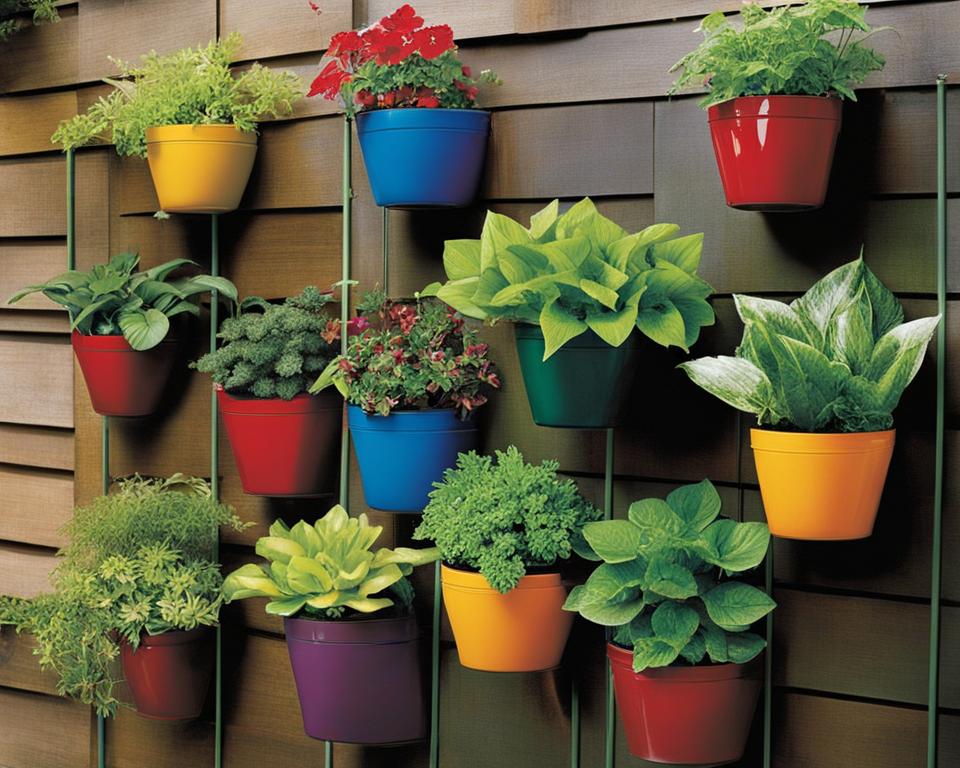Gardening is a wonderful way to connect with nature, but sometimes space constraints can limit our gardening dreams. That’s where vertical container gardening systems come in! With these innovative systems, you can garden even in the smallest of spaces. Whether you have a tiny balcony or a cozy backyard, vertical gardening allows you to maximize your garden space and unleash your creativity.
Vertical container gardening systems offer a host of benefits that traditional gardening methods simply can’t match. Not only do they allow for easier harvesting and healthier plants, but they also create stunningly beautiful garden designs that are sure to impress. Plus, vertical gardening is an affordable option for any budget, making it accessible to all aspiring gardeners.
In this article, I will guide you through the world of vertical container gardening systems, providing you with a wealth of container gardening ideas and DIY tips. Get ready to transform your home into a lush green oasis with these space-saving gardening solutions!
Key Takeaways:
- Vertical container gardening systems maximize limited garden space.
- These systems offer numerous benefits, including easy harvesting and healthier plants.
- Vertical gardening allows for stunning garden designs that are visually appealing.
- Vertical container gardening can be adapted to fit any budget.
- DIY ideas and tips will help you create your own vertical gardening system.
The Benefits of Vertical Gardening
Vertical gardening offers several advantages for small-space and urban gardeners. It allows you to grow more plants in a limited area, making it ideal for balconies, patios, and small yards. Vertical garden designs can add visual interest and structure to your garden, creating a unique and appealing outdoor space. Additionally, by growing plants vertically, you can reduce the risk of pests and diseases, as well as save your back and knees from the strain of traditional gardening.
Small-space gardening can be a challenge, but vertical gardening provides a practical solution. By utilizing vertical space, you can maximize your gardening potential and create a beautiful oasis even in the smallest of areas. Whether you have a tiny balcony or a narrow strip of land, vertical gardening allows you to make the most of every square inch.
“Vertical garden designs can transform ordinary spaces into stunning displays of greenery.” – Vertical Gardening Enthusiast
In addition to their space-saving benefits, vertical gardens can also enhance the aesthetics of your outdoor space. By incorporating vertical structures such as trellises, hanging baskets, or wall-mounted planters, you can create a visually stunning garden design that is sure to impress. Vertical gardens provide an opportunity to play with different textures, colors, and varieties of plants, resulting in a unique and captivating landscape.
The Advantages of Vertical Gardening:
- Maximizes gardening potential in small spaces
- Reduces the risk of pests and diseases
- Creates visually appealing garden designs
- Saves time and effort by minimizing bending and kneeling
With its numerous benefits, it’s no wonder that vertical gardening has become increasingly popular among urban and small-space gardeners. Whether you’re a beginner or an experienced gardener, vertical gardening provides an innovative and practical solution for cultivating a thriving garden in limited spaces.
Choosing the Right Vertical Gardening System
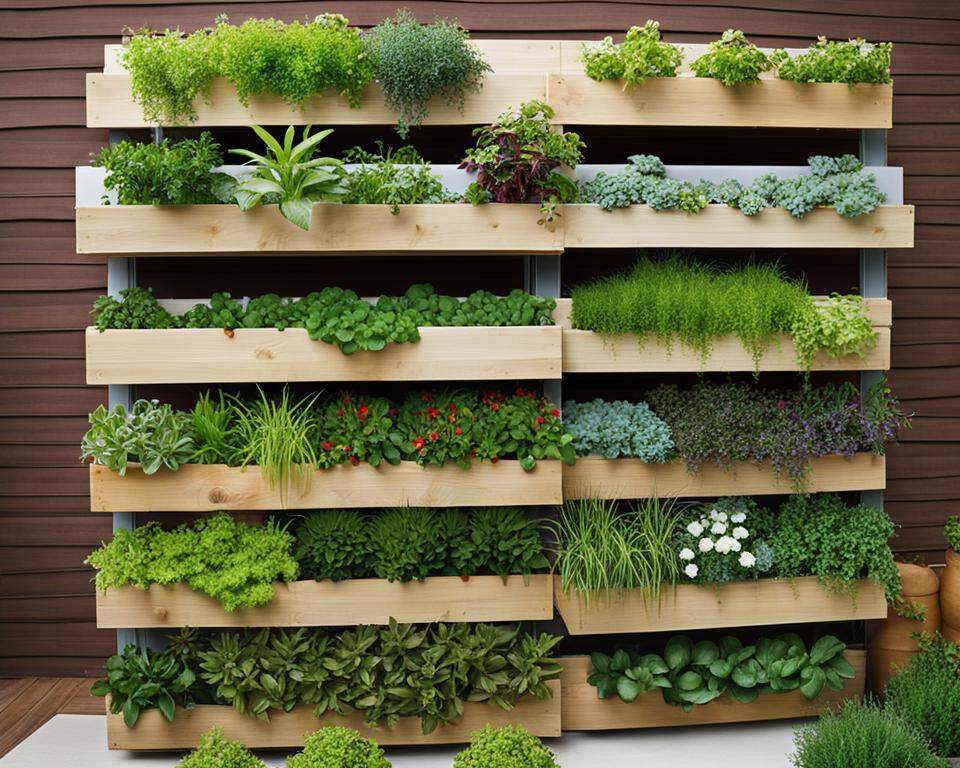
When it comes to vertical gardening, choosing the right system is crucial for success. With a variety of options available, including vertical planters, trellises, and hanging baskets, you’ll need to consider factors such as space, plant type, and budget.
For balcony gardening and small-space gardening, vertical planters are a popular choice. These compact containers provide support for your plants and can be easily installed on walls or railings. They come in various sizes and designs, allowing you to create a customized vertical garden that fits your space perfectly.
If you have a larger area to work with, trellises are a great option. These structures provide vertical support for climbing plants and can be placed directly in the ground or attached to fences or walls. Trellises come in different materials, such as wood or metal, and can add a beautiful aesthetic to your garden.
When selecting a vertical gardening system, it’s important to consider the maintenance and watering requirements. Some systems may be easier to maintain and provide better drainage than others. Additionally, make sure the system you choose can adequately support the weight of your plants as they grow.
Table: A Comparison of Vertical Gardening Systems
| System | Pros | Cons |
|---|---|---|
| Vertical Planters | – Space-saving – Easy installation – Customizable – Suitable for small spaces |
– Limited plant capacity – Need frequent watering |
| Trellises | – Provides support for climbing plants – Adds visual interest – Suitable for larger areas |
– Requires installation – May need additional support for heavier plants |
| Hanging Baskets | – Allows for cascading plants – Adds vertical depth – Easy to move around |
– Limited plant capacity – Requires frequent watering |
Remember, the right vertical gardening system will depend on your specific needs and preferences. Take the time to research and explore different options before making a decision. With the right system in place, you’ll be on your way to creating a stunning vertical garden that maximizes your space and brings beauty to your surroundings.
DIY Vertical Gardening Ideas
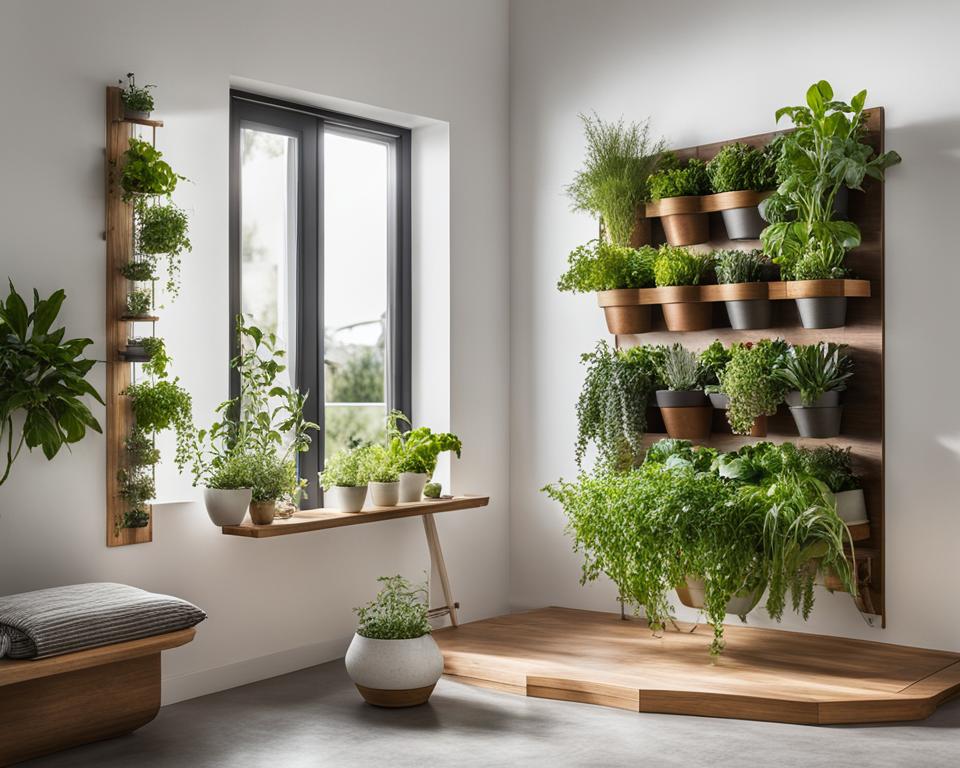
Creating your own DIY vertical gardening system can be a cost-effective and creative solution. There are several materials you can use, such as welded wire, T-posts, cattle panels, chicken wire, and recycled fencing. These materials can be easily obtained and repurposed for vertical gardening, allowing you to save money while still achieving a functional and visually appealing garden.
One popular DIY idea is to create arched trellises using welded wire or cattle panels. These trellises can be installed against a wall or used to create separate garden areas in your yard. The arches add height and visual interest to your garden while providing support for climbing plants.
Another vertical gardening idea is to repurpose old wooden pallets. By attaching small pots or planters to the pallets, you can create a vertical garden that can be mounted on a wall or leaned against a fence. This is a great way to maximize space and create a unique and rustic look for your garden.
If you’re looking for a compact and space-saving solution, consider using recycled materials such as plastic bottles or PVC pipes. These materials can be fashioned into vertical planters or towers, allowing you to grow a variety of plants in a small footprint. This is especially useful for balcony gardens or urban spaces where space is limited.
Table: DIY Vertical Gardening Materials
| Material | Description |
|---|---|
| Welded wire | Sturdy and versatile material for creating trellises and support structures. |
| T-posts | Metal posts that can be driven into the ground to create vertical supports for plants. |
| Cattle panels | Heavy-duty wire panels that can be used to create arched trellises and fencing. |
| Chicken wire | Lightweight wire mesh that can be shaped into planters and support structures. |
| Recycled fencing | Old fencing material that can be repurposed for vertical gardening. |
| Plastic bottles | Empty plastic bottles that can be cut and stacked to create vertical planters. |
| PVC pipes | Rigid plastic pipes that can be used to construct vertical towers for growing plants. |
Best Plants for Vertical Gardening
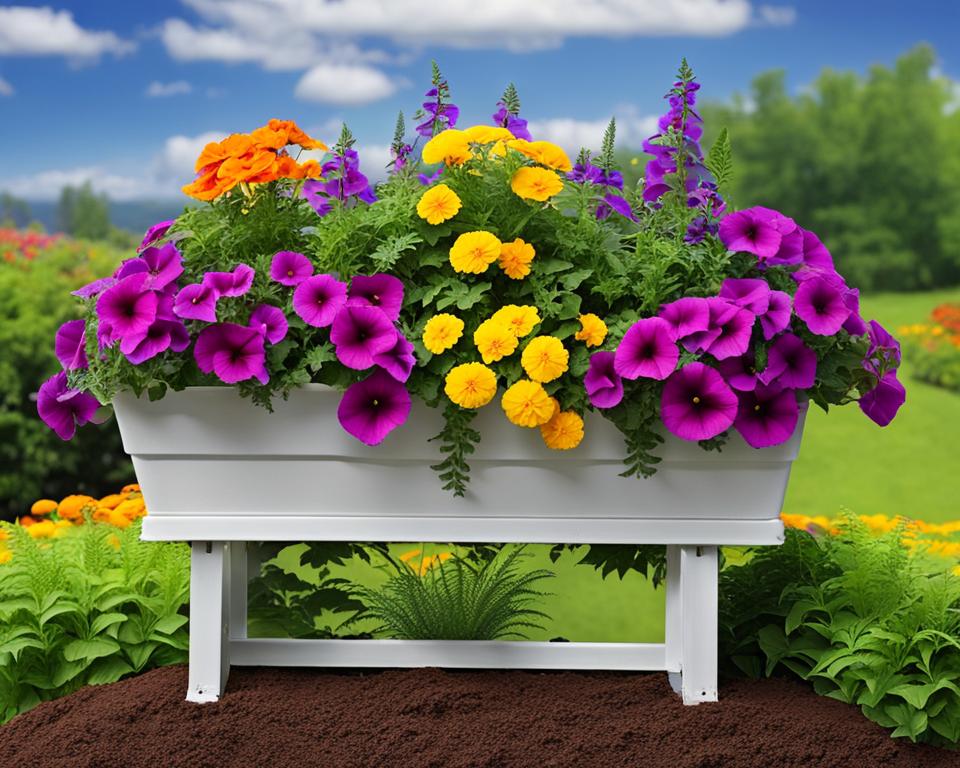
In vertical gardening, choosing the right plants is crucial for the success of your garden. Certain plants are more suitable for trellises, vertical planters, and climbing structures. Here are some of the best plants for vertical gardening:
- Climbing beans: These fast-growing beans are perfect for trellises and can produce a bountiful harvest. They add a touch of greenery and provide delicious produce.
- Cucumbers: Cucumbers thrive when grown vertically and can be trained to climb up trellises or fences. They take advantage of vertical space and yield crisp and refreshing fruits.
- Tomatoes: Tomatoes are popular choices for vertical gardening. They can be supported by trellises or stakes and offer abundant harvests of juicy and flavorful tomatoes.
- Peas: Peas are excellent climbers and can be grown on trellises or netting. They add beauty to your vertical garden and provide a tasty and nutritious crop.
- Squashes: Certain squash varieties, such as zucchini and yellow squash, can be grown vertically with the help of sturdy trellises. They save space and produce an abundance of delicious vegetables.
“Vertical gardening provides opportunities to grow a wide range of plants in a limited space. By selecting the right plants, you can create a thriving vertical garden that not only saves space but also provides a beautiful and productive outdoor oasis.” – Vertical Gardening Enthusiast
Aside from the above mentioned vegetables, there are also perennial vines that are suitable for vertical gardening. Clematis, American bittersweet, and ivy are great choices for adding vertical interest to your garden. They can be trained to climb on structures or walls, creating a stunning visual display.
When choosing plants for trellises and vertical planters, consider their growth habits, light requirements, and support needs. Ensure that the plants you select are suitable for your climate and can thrive in a vertical growing environment.
Vertical Gardening Indoors
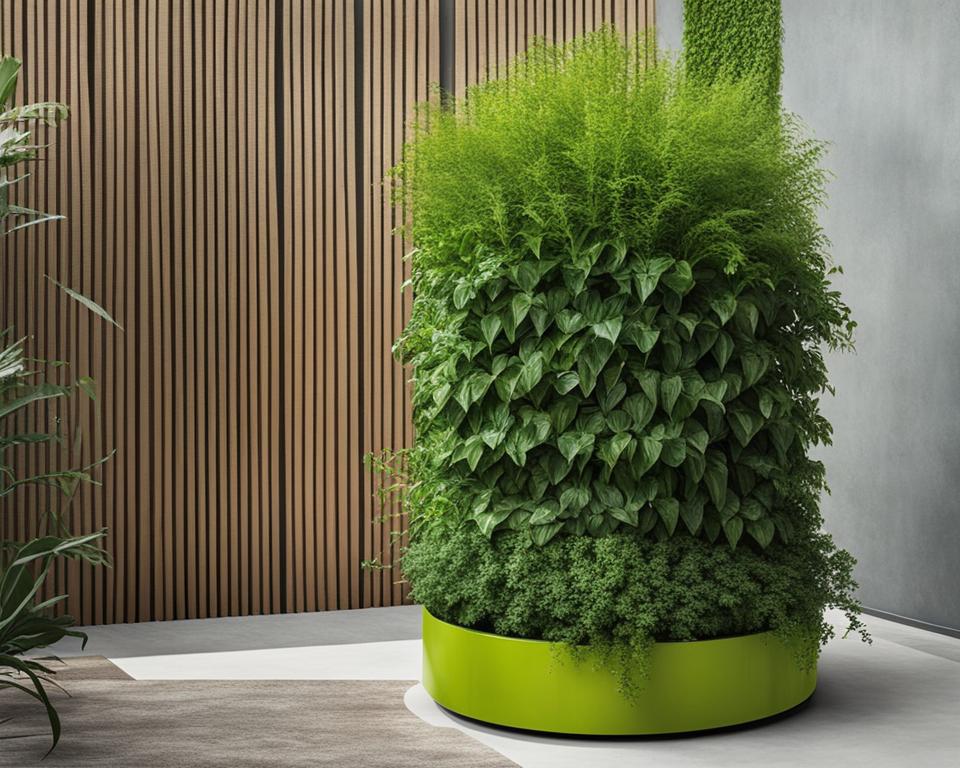
Indoor vertical gardening, also known as living walls, is a fantastic way to bring the beauty of plants into your home while maximizing space. It creates a stunning visual display and adds a touch of nature to any room. Not only are indoor vertical gardens aesthetically pleasing, but they also have numerous benefits for your indoor environment. They can improve air quality by reducing toxins and increasing oxygen levels, as well as add humidity to dry indoor spaces.
To create an indoor vertical garden, you have several options. One popular method is using modular systems specifically designed for living walls. These systems are easy to install and allow you to customize the layout and arrangement of your plants. Another option is to attach climbing plants directly to your walls using hooks or trellises. This method gives you more flexibility in terms of plant selection and allows you to create unique designs.
When choosing plants for your indoor vertical garden, consider the light conditions in your home. Some plants thrive in bright, indirect light, while others prefer low-light environments. It’s important to select plants that are well-suited to the specific conditions of your space to ensure their health and growth. Some popular choices for indoor vertical gardening include pothos, spider plants, philodendrons, and various ferns.
| Benefits of Indoor Vertical Gardening | Plants Suitable for Indoor Vertical Gardens |
|---|---|
| * Improved air quality * Increased humidity * Aesthetically pleasing * Space-saving * Stress reduction |
* Pothos * Spider plants * Philodendrons * Ferns * Succulents |
Indoor vertical gardening is a versatile and rewarding way to incorporate plants into your living space. Whether you choose a modular system or opt for a more DIY approach, the benefits of indoor vertical gardening are undeniable. Create your own living wall and transform your home into a green oasis.
Green Walls and Vegetal Structures
Green walls, popularized by botanist Patrick Blanc, have become a prominent feature in modern vertical gardening. They involve creating structures covered with climbing plants, which can be attached to walls or stand alone as vertical plant walls. Green walls are not only a unique and artistic addition to your outdoor or indoor space, but they also provide a range of benefits for both the environment and your well-being.
These vegetal walls serve as living paintings, adding a natural touch to any space. They can improve air quality by filtering pollutants and absorbing carbon dioxide, and even help to reduce noise pollution. Green walls also contribute to the overall aesthetics of a place, creating a visually stunning and inviting atmosphere. They have gained popularity in architectural design, transforming buildings into vibrant and sustainable structures.
When creating a green wall, it is essential to consider proper framing, waterproofing, and plant selection. The framing should provide stability and support for the plants, ensuring their long-term growth and health. Waterproofing is necessary to protect the building structure and prevent water damage. Selecting the right plants is crucial to ensure the success of the green wall, as different species have varying light and water requirements. By carefully planning and implementing these factors, you can create a striking green wall that adds beauty and benefits to your space.
I believe that green walls are a testament to our commitment to living harmoniously with nature. They are a visual representation of our desire to incorporate greenery into our urban environments, fostering a deeper connection with the natural world.
Creating a green wall requires careful consideration and expertise, making it an ideal project for professional landscape designers or experienced gardeners. However, with proper research and guidance, it is possible to create smaller-scale green walls or vegetal structures on your own. Whether you choose to incorporate a green wall into your outdoor space or bring the beauty of climbing plants indoors, these vertical garden structures offer a unique and sustainable way to enhance your surroundings.
Vertical Garden Design Considerations
When designing a vertical garden, there are several important considerations to keep in mind. These factors will not only contribute to the overall success of your garden but also ensure that it remains visually appealing and functional. Below, I will outline some key design considerations for your vertical garden.
1. Stability and Support
One of the most crucial aspects of vertical garden design is ensuring the stability and support of your structures. Whether you’re using trellises, arbors, or other support systems, it’s important to ensure that they are securely anchored and capable of withstanding the weight of your plants. Consider the materials you are using and their ability to withstand weather conditions. Additionally, be mindful of the strength and durability of the attachment points to walls or other surfaces.
2. Sunlight Exposure
The amount of sunlight your vertical garden receives will directly impact the growth and health of your plants. Before installing your vertical garden, assess the amount of sunlight available in the location. Some plants thrive in full sun, while others prefer partial or dappled shade. Be sure to select plants that are well-suited for the specific lighting conditions of your vertical garden. Additionally, consider the orientation of your structures to optimize sun exposure throughout the day.
3. Watering and Maintenance
Vertical gardens often require more frequent watering than traditional gardens due to increased exposure to sunlight and wind. Consider implementing an irrigation system or utilizing self-watering containers to ensure consistent moisture levels for your plants. Additionally, factor in the accessibility of your vertical garden for maintenance tasks such as pruning, fertilizing, and pest control. Design your garden in a way that allows for easy access and maintenance to keep your plants healthy and thriving.
| Design Considerations | Tips |
|---|---|
| Spacing | Ensure adequate spacing between plants to allow for proper airflow and to prevent shading of neighboring plants. |
| Plant Selection | Choose plants that are suitable for vertical growth and consider their specific light and water requirements. |
| Visual Appeal | Experiment with different textures, colors, and heights of plants to create an aesthetically pleasing vertical garden design. |
| Seasonal Considerations | Plan your vertical garden to include plants that provide year-round interest, considering their bloom times and foliage color changes. |
By taking these design considerations into account, you can create a thriving and visually appealing vertical garden that brings beauty and nature into any space. Remember to prioritize stability, sun exposure, and proper maintenance to ensure the long-term success of your vertical garden.
Support Structures for Vertical Gardening
When it comes to vertical gardening, support structures are essential for the success and functionality of your garden. Trellises, arbors, obelisks, and other vertical garden support structures provide the necessary framework for climbing plants to thrive and help define the vertical spaces in your garden.
Trellises are popular support structures that can be made from various materials such as wood, metal, or recycled materials. They are designed to provide stability and support for climbing plants, allowing them to grow vertically and create a stunning visual display. Arbors, on the other hand, offer a more decorative element to your vertical garden. They often feature arches or lattice designs and can be used to create beautiful entrances or focal points in your garden.
Obelisks are another type of support structure that adds height and interest to your vertical garden. These tall, pyramid-shaped structures are often made from metal or wood and provide a striking vertical element for climbing plants to grow on. They can be placed strategically throughout your garden to create visual variety and maximize growing space.
Choosing the Right Support Structure
When selecting a support structure for your vertical garden, consider factors such as the size of your plants, the weight they will bear, and the overall design aesthetic you want to achieve. It’s important to choose a structure that is sturdy, durable, and capable of withstanding the elements.
Additionally, consider the material of the support structure. Wood is a popular choice for trellises and arbors due to its natural look and versatility. Metal structures, such as those made from wrought iron or steel, offer durability and a sleek, modern aesthetic. Recycled materials, such as repurposed pallets or ladders, can also be used to create unique and environmentally-friendly support structures for your vertical garden.
| Support Structure | Pros | Cons |
|---|---|---|
| Trellises | Provides support for climbing plants, visually appealing, versatile | May require regular maintenance, can be susceptible to weather damage |
| Arbors | Adds a decorative element, creates focal points, provides shade | Requires more space, may require regular pruning and maintenance |
| Obelisks | Offers vertical interest, adds height to the garden, visually striking | May be more expensive, limited space for planting |
When designing your vertical garden, consider the placement and spacing of your support structures to ensure proper airflow and light distribution. This will help prevent shading and improve the overall health and growth of your plants. With the right support structures in place, you can create a stunning and productive vertical garden that will be the envy of your neighbors.
Maintenance and Care for Vertical Gardens
Maintaining a vertical garden is essential for its long-term health and productivity. Regular watering, fertilizing, pruning, and pest control are crucial tasks that should be incorporated into your gardening routine. Additionally, monitoring the moisture levels of the soil and providing appropriate support for your plants are key considerations in vertical garden maintenance.
The most important aspect of maintaining a vertical garden is watering. Vertical gardens, due to their exposed nature, can dry out more quickly than traditional gardens. It is important to regularly check the moisture levels of the soil and water accordingly. A drip irrigation system can be a convenient and efficient way to ensure consistent moisture levels in your vertical garden. Alternatively, hand-watering or using a watering can with a fine spray nozzle can also be effective.
In addition to watering, fertilizing your vertical garden is essential for the healthy growth of your plants. Consider using a slow-release or organic fertilizer to provide the necessary nutrients. Be mindful not to over-fertilize, as this can lead to excessive growth and weaken the plants. Always follow the instructions on the fertilizer package and adjust the dosage based on the specific needs of your plants.
Pruning is another important aspect of vertical garden maintenance. Regularly inspect your plants for any dead or damaged branches and remove them to maintain the overall health and appearance of your garden. Pruning also helps to promote airflow and prevent the spread of diseases. Additionally, train and guide your plants along trellises or support structures to encourage vertical growth and maintain the desired shape of your garden.
Key Maintenance Tips for Vertical Gardens:
- Regularly check moisture levels and water accordingly. Consider using a drip irrigation system or hand-watering with a fine spray nozzle.
- Fertilize your plants with a slow-release or organic fertilizer to provide necessary nutrients. Avoid over-fertilizing.
- Prune dead or damaged branches and guide plants along support structures to maintain health and shape.
- Monitor your vertical garden for pests and diseases. Take appropriate action to prevent and treat any issues that arise.
- Inspect support structures for stability and make any necessary repairs or adjustments.
By following these maintenance tips, you can ensure the health and vitality of your vertical garden and enjoy a bountiful and beautiful harvest.
| Vertical Garden Maintenance Checklist | Frequency |
|---|---|
| Check soil moisture levels | Every 1-2 days |
| Watering | Regularly, as needed |
| Fertilizing | Monthly or as directed by fertilizer package |
| Pruning | As needed to remove dead or damaged branches |
| Pest and disease control | Regular monitoring and appropriate action |
| Support structure inspection | Periodically, especially after inclement weather |
Vertical Gardening for All Spaces and Budgets
Creating a vertical garden doesn’t have to break the bank. With affordable solutions and a bit of resourcefulness, you can transform any space into a thriving vertical garden. Whether you have a small balcony or a large yard, vertical gardening offers a versatile and budget-friendly way to grow plants.
One cost-effective option for vertical gardening is to create your own DIY system using recycled materials. By repurposing items like pallets, old gutters, or PVC pipes, you can build custom planters or trellises that fit your space perfectly. Not only will this help you save money, but it also allows for creative and unique designs.
Another budget-friendly approach to vertical gardening is to choose low-cost plants that are well-suited for vertical growth. Climbing plants like beans, peas, and cucumbers are not only productive but also add lush greenery to your vertical garden. Additionally, herbs like basil, mint, and parsley are compact and perfect for small vertical gardens.
Table: Budget-Friendly Materials for DIY Vertical Gardening
| Material | Description |
|---|---|
| Recycled Pallets | Can be used to create vertical planters or trellises |
| Old Gutters | Make excellent vertical planters when mounted on a wall or fence |
| PVC Pipes | Can be cut into various lengths to create vertical planters or support structures |
| Soda Bottles | When cut in half, they can be used as individual planters |
Table: Low-Cost Plants for Vertical Gardening
| Plant | Description |
|---|---|
| Climbing Beans | Fast-growing and productive, perfect for trellises |
| Peas | Delicious and versatile, can be grown in containers or on trellises |
| Cucumbers | Compact and prolific, ideal for vertical gardens |
| Basil | Herb with a variety of uses, grows well in vertical planters |
By combining affordable materials and selecting the right plants, you can create a vertical garden that not only fits your budget but also brings beauty and productivity to any space. So, get creative and start your own affordable vertical gardening project today!
Conclusion
In conclusion, vertical container gardening systems offer a multitude of benefits for gardeners of all spaces and budgets. By embracing vertical gardening ideas and techniques, you can maximize your garden space and create a visually stunning outdoor oasis. Whether you have a small balcony or a large yard, vertical gardening provides an innovative and rewarding solution for growing plants in limited spaces.
With the right selection of plants and support structures, you can create a flourishing vertical garden that not only enhances your outdoor space but also contributes to a healthier environment. Vertical gardening allows you to grow more plants in a smaller area, making it ideal for small-space and urban gardeners. By going vertical, you can enjoy the convenience of easier harvesting and the added benefit of reducing strain on your body.
So why not start your own vertical container gardening system today? With some creativity, resourcefulness, and a little bit of maintenance, you can transform any space into a thriving vertical garden. Experience the joy of gardening in a whole new way and reap the rewards of a beautiful, productive, and sustainable garden right at your doorstep.
FAQ
What are the benefits of vertical gardening?
Vertical gardening offers benefits such as maximizing limited space, easier harvesting, healthier plants, and beautiful garden designs.
What types of plants are suitable for vertical gardening?
Plants like climbing beans, cucumbers, melons, and tomatoes are excellent choices for trellises and vertical planters. Perennial vines like clematis, American bittersweet, and ivy can also be used for vertical interest.
What are some DIY ideas for creating a vertical gardening system?
You can create your own vertical gardening system using materials like welded wire, T-posts, cattle panels, and recycled fencing. DIY arched trellises and vertical planters made from recycled materials are great options.
Can vertical gardening be done indoors?
Yes, indoor vertical gardening, also known as living walls, can be achieved using modular systems or by attaching climbing plants to walls.
How do I choose the right support structures for vertical gardening?
Consider factors such as stability, sunlight exposure, and plant support when selecting trellises, arbors, or obelisks for your vertical garden.
What maintenance is required for vertical gardens?
Regular watering, fertilizing, pruning, and pest control are important for the health and vitality of vertical gardens. Monitoring moisture levels and adjusting watering accordingly is also necessary.
Can vertical gardening be done on a limited budget?
Yes, vertical gardening can be adapted to fit any space and budget. DIY solutions using affordable materials are a cost-effective way to achieve a functional and visually appealing vertical garden.

